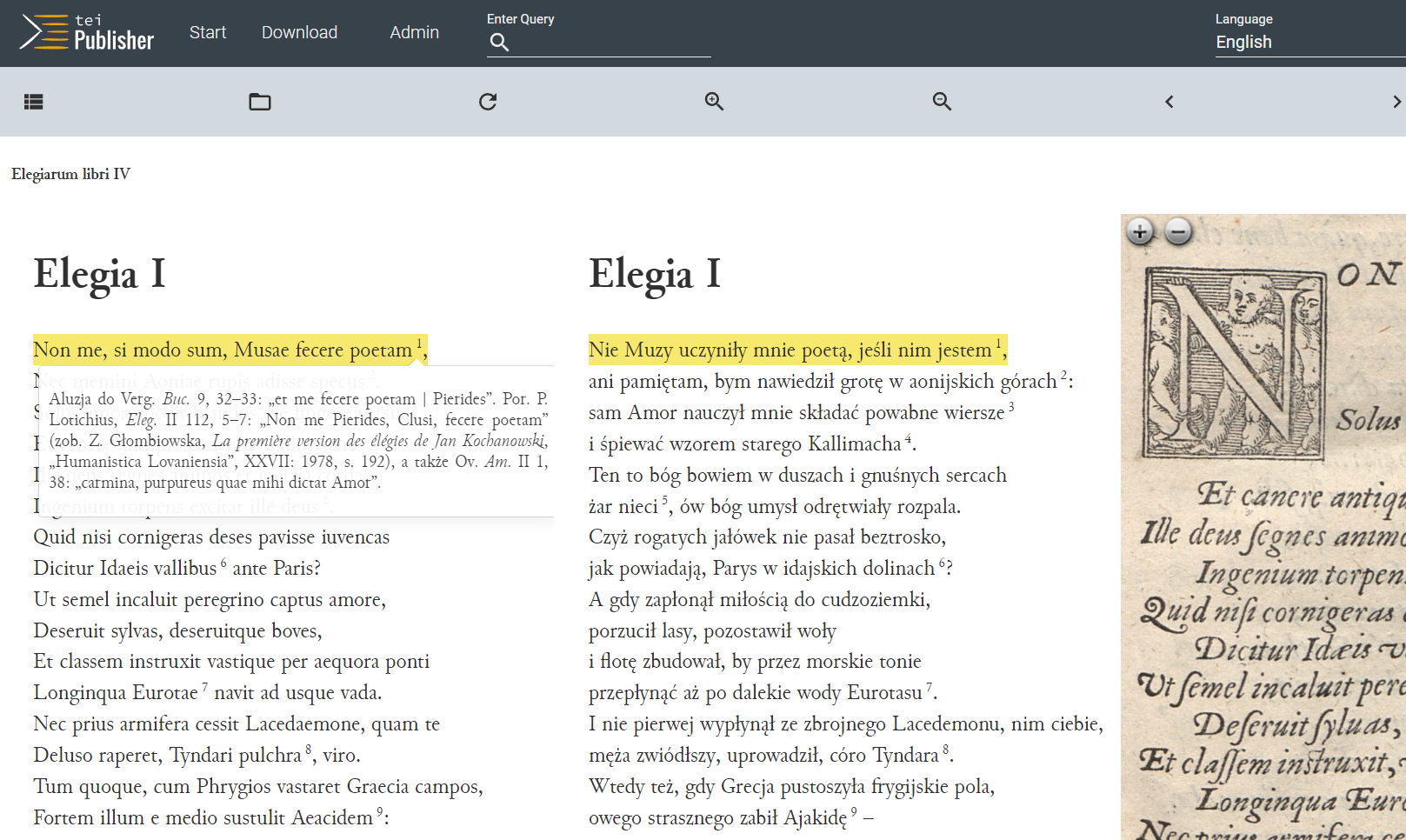
We are presenting a new version of NEOLATINA – a repository of critical editions of Latin texts created by authors associated with the former Polish-Lithuanian Commonwealth, the state consisting of the Kingdom of Poland, Grand Duchy of Lithuania, Royal Prussia, and Duchy of Prussia. NEOLATINA was established in Renaissance Literature Lab at the Faculty of Polish Studies of the Jagiellonian University, and is maintained in the Jagiellonian Centre for Digital Humanities and developed with TEI publisher. The funding is provided by the Jagiellonian University’s Flagship Project “Digital Humanities Lab”.
The first version (http:// neolatina.bj.uj.edu.pl /neolatina/) was created in the years 2006−2011, with the view to building a digital platform housing the first modern translation and critical edition of the complete Latin works by Jan Kochanowski (1530−1584), a Renaissance Humanist considered the most important and influential Slavic poet until the end of the modern era. Kochanowski’s enormous impact on Polish literature and culture had been widely recognized and thoroughly researched, whereas his Latin output did not garner much attention on the part of scholars or editors. Suffice it to say that in the 20 th -century there was only one critical edition from 1884, with no commentary.
When planning the modern edition supplied with the rich philological (Classical and Neo-Latin) as well as cultural and historical commentary, we estimated that the state of research on Cochanovius Latinus was insufficient for a printed edition, which would become a canonical one. That is why we decided on the digital edition formula, which would be subject to changes prompted by ongoing research and new findings. Another important part of the project was to retranslate Kochanowski’s humanistic Latin, with the two extant translations coming from the 1880s (a philological translation) and the 1950s (a poetic translation based on that old philological one). Our open-access annotated edition in NEOLATINA , accompanied by the collection of studies, inspired new works on Kochanowski’s poetry in Latin and its editions. See: Głombiowska, Z. (2008), (2013), and Cabras, F. (2019). The most recent edition is currently in progress within Kochanowski’s Completed Works , and NEOLATINA ’s team members are taking part in it.
Published 10 years ago, our electronic platform presented the content in a static way, with the transcription, translation and facsimile views accessible as separate files due to the technological limitations of the HTML structures. It did not allow comparison, searching or problem-reading. The design of the new version is based on semantic principles and uses tools that allow transcription, translation and text-tracking data to be combined simultaneously in two or more languages. This is intended to make the texts accessible to readers with a diverse range of reading and digital competencies, including researchers who are well versed in the original language, less skilled readers who are taking their first steps in linguistic research, as well readers who require additional support tools.
The new version of the service (neolatina.dhlab.uj.edu.pl) is based on TEI Publisher, see: Turska, M., Meier, W. (2023). This system meets standards of Text Encoding Initiative (TEI) and uses TEI Processing Model, customising the appearance of the text is all done in TEI ODD by mapping each TEI element to a limited set of well-defined behaviour functions. It is multilingual in the sense that the texts are segmented in such a way that it is possible to compare different language versions, search for similar structures at the level of language commentary and compare text fragments between the original, translation and facsimile. Entire textual units are cross-referenced in transcription, translation and facsimile. Additionally, contextual, linguistic, historical and geographical comments will be provided according to the needs of the reader, and accessible by choosing one of the language versions of the text.

Fig. 1. Comparative view of transcription, translation and facsimile, with a comment accessed through the Latin version.

Fig. 2. Comparative view of transcription, translation and facsimile with a comment accessed through the Polish version.
In recent years, many previously unknown Latin texts produced in the Polish-Lithuanian Commonwealth have been discovered in the libraries of Lithuania and, particularly valuable today, in Ukraine and Belarus, which were fortunately copied before the war by Polish and Lithuanian scholars. Many of these texts are now endangered by warfare. The repository is open to collaboration with academics who come with their projects and seeking for a virtual space to deposit their findings. We aim to develop standards for digital editions of Neo-Latin texts and tools necessary for their creation. The metadata has been separated into collections that can be used in other projects.
|
I. Neolatina |
II. Old Polish Translations of European Classics | III. New Translations of Old European Poetry |
| Collections : | Collections : | Collections : |
|
1. Jan Kochanowski Cochanovius Latinus / Latin works Elegiae, Lyrica, Epigrammata Pastoralia, Varia |
1. Roman Vergilius/P.Kochanowski, Aeneis (1590) Ovidius/W.Otwinowski, Metamorphoseon libri (1638) Seneca/J.A.Bardziński, Tragedie (1696) |
1. Medieval Latin, Mozarabic Hispano-Arabic Galician-Portuguese Occitan Old-French |
|
2. Auctores Sarmatici Latini The catalogue of N-L authors connected with Pol.-Lith. Republic |
2. Italian T.Tasso/J.A.Morsztyn, Amyntas (1650) T.Tasso/P.Kochanowski, Goffred abo Jeruzalem wyzwolowna (1618) G.B.Guarini/S.Lubomirski, Pastor Fido (1722) |
2. Renaissance |
|
3. Separate works linked to the catalogue of N-L authors |
||
| 4. Neo-Latin text from the libraries in East Europe |
3. Belgian J.Lipsius, De Constantia/J.Piotrowicz, O stałości (1649) |
3. Baroque |
Fig. 3. Plans for development of the platform.